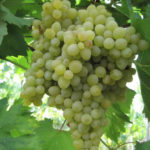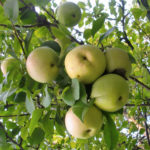Pear variety Forest beauty
The forest beauty is an autumn pear of Belgian origin. At the beginning of the 19th century, his trees were accidentally discovered in the Chatillon forest while traveling in the vicinity of Alost in the east of Flanders (Belgium). According to Grebnitsky's version (Atlas of Fruits, 1906), a certain Fario in Deftingen (Belgium) got the new variety through sowing seeds, after which Van Mons began to spread it in 1810.

According to the VNIISPK catalog, the Forest Beauty has other names: Alexandrina, Marie-Louise. However, in European pomology, Forest Beauty and Marie Louise have nothing in common with each other, they are two completely different varieties. According to Semerenko, this pear is also called Butterwood.
Subsequently, the variety became widespread in the republics of Central Asia, Belarus, Ukraine, Lithuania, Moldova and Estonia. On the territory of Russia, this pear was zoned in the North Caucasus and in the Lower Volga region.
Trees of medium size, at a young age (up to 8 - 10 years) are characterized by rapid growth. The crown is medium-leafy, broad-pyramidal, with slightly drooping branches. Fruit formations are located mainly on 3 - 4-year-old wood. Shoots are rather thick, straight or slightly arcuate, colored dark red. Lentils are medium in size, few in number. The buds are small in size, with a metallic shade. The edges of the leaves are serrated with finely serrated or finely serrated serrations. Petioles are long, thin in thickness.

The flowers are pinkish in color, small in size. Flowering occurs in medium terms. The flowers are highly resistant to temperature changes in the spring. The variety is partially self-fertile. The best pollinators for the Forest Beauty can be varieties: Williams, Limonka, Josephine Mechelnaya.
The fruits are of medium size (average weight of a pear is 120 - 140 g, in very rare cases the weight of fruits reaches 250 - 300 g) and blunt-ovoid. The skin is thin, but at the same time quite dense, small roughness is noticeable on its surface. The main color of the fruit during the removable period is greenish-yellow, when ripe it is golden-yellow. Also, during the ripening period, an integumentary color appears on the skin of the fruit from the sunny side in the form of a bright beautiful blush, gray dots and rusty spots are formed. Peduncles are short, thick, straight, with a bell at the apex. The funnel is small in size, narrow in shape. Open cup. The saucer is small in size, wide, with a smooth surface. The heart has a wide fusiform shape and is slightly outlined by small stony formations. Seed chambers of a closed or semi-open type, elongated, ovoid; the axial cavity is hollow. Seeds are large, well developed, pointed upwards, dark brown in color.

The pulp is white with a yellowish tinge, sweet and sour taste, buttery, tender, juicy, with high taste. According to the chemical composition, the fruits of the Forest Beauty grown in the conditions of the Kuban contain: the sum of sugars (8.5%), dry substances (13.8%), titratable acids (0.23%), P-active catechins (35.3 mg / 100 g fr wt), ascorbic acid (7.4 mg / 100 g).
The period of removable fruit ripeness falls on the second half of August (from the 20th to the 30th). The keeping quality of the pear is low, the fruits are stored for no more than 2 - 3 weeks. Since the fruits at full maturity very quickly overripe, crumble and are little stored, it is recommended to harvest 5-10 days earlier. Overripe fruits "swell". Most of the fruits are consumed fresh, but they are also very well suited for cooking compotes.
The variety works well on quince and wild forest pear. Trees grafted on quince begin to bear fruit in the 4th - 5th year, on a wild pear - not earlier than the 7th year, on vigorous rootstocks - on the 6th - 7th year. In general, fruiting is regular, but in quantitative terms it fluctuates from year to year. It is noted that the largest harvests fall on normal or cool summers, the poorest harvests fall on hot years.The average yield of trees 12 - 15 years old growing in the central Kuban is 140 - 160 c / ha, and at the age of 17 - 20 years under the conditions of the eastern Kuban subzone - 120 c / ha.

The variety is unpretentious to soil conditions: trees grow well both on moderately moist and relatively dry soils. However, trees growing on deep, nutritious, loose soils are guaranteed ideal growth and fruiting. It is also worth noting that the trees of this pear are very durable.
The winter hardiness of the Forest Beauty is recognized as the highest among all Western European varieties (up to minus 45 ° C). Drought tolerance is also very high. However, scab resistance is extremely low.
The main advantages of the variety include: high palatability of fruits, high yield and winter hardiness of trees, unpretentiousness in various growing conditions.
Among the main disadvantages, there is a strong susceptibility to scab of fruits and leaves, shedding of ripe fruits.
The forest beauty was often used in breeding work as an initial form. With her participation, more than 30 new varieties were bred, of which 11 have already been zoned (included in the State Register). Among them: Marble and Dessertnaya Rossoshanskaya selection of the Rossoshanskaya zonal fruit and berry experimental station (both varieties obtained through hybridization Bere zimnyaya Michurina x Lesnaya krasavitsa), Dubovskaya early selection of the Dubovski support point of the Lower Volga Research Institute of Agriculture (Williams x Lesnaya Krasavitsa), Lada selection of the Moscow Agricultural Academy (Olga x Lesnaya Krasavitsa) , A small selection of the Krasnoyarsk Experimental Fruit Growing Station (Ussuriyskaya x Seedling of the Forest Beauty), Favorite Klapp of the selection of the American originator T. Klapp (USA, through free pollination of the Forest Beauty).









For me, the forest beauty is the most delicious pear, very juicy and unpretentious. The fruits are not stored, they often fall from the tree and break on the ground. Delicious jam is obtained from this variety, and you can also make dried fruits. The tree grows large and is always covered with pears.
This variety brings back memories from childhood. Then, visiting my grandfather in the garden, it was impossible to resist and not pick a juicy, fragrant fruit from the tree. The juice literally poured down my collar. At the same time, by pulling on a branch, one could get pears falling from the tree on the head. Grandpa always grumbled about this.
We also planted the Forest Beauty on the site. We collect a bountiful harvest (4 buckets + what has fallen) for the second year. I solve the problem of safety simply - I distill it in a juicer. The yield is not as big as with apples or grapes, but how sweet it is.
How to understand - I am distilling on a juicer? Maybe on a juicer?
Juice cooker is meant. Take a look at google.
I planted the forest beauty due to winter hardiness at -45 degrees! In the first year, the seedlings froze to the level of snow, and this spring shoots from the trunks began. The roots did not freeze, the plants did not freeze before the grafting. Now I want to put some of the branches into the stanza and so try to grow it with a tree.